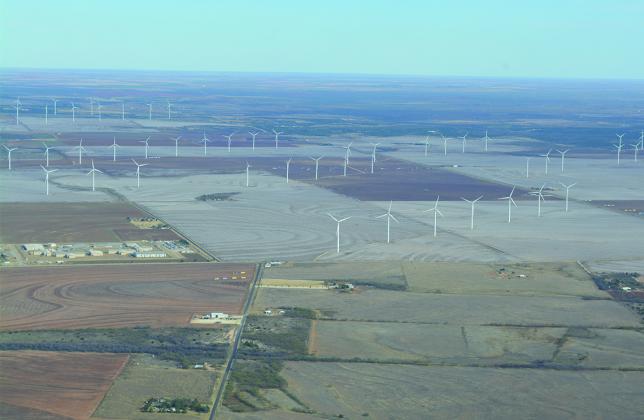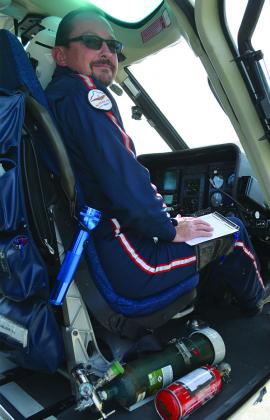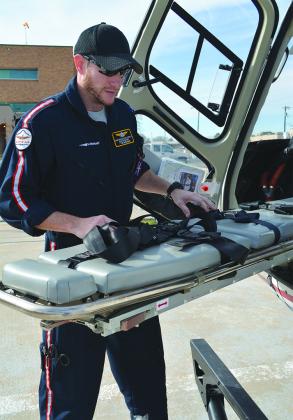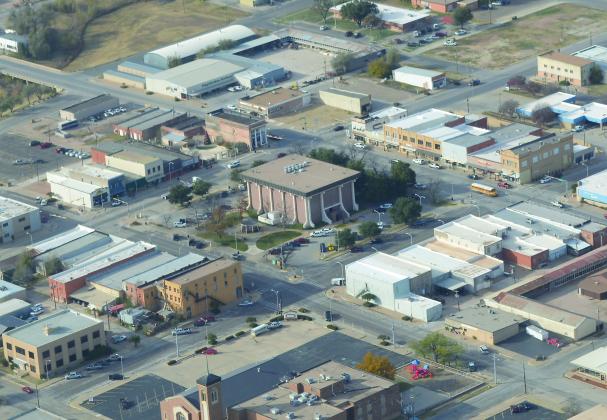This time of year children scour the skies, hoping to catch a glimpse of Santa Claus. But they might be surprised to see something else instead.
Flying high above Snyder and the surrounding area, a Native Air AS350 helicopter can be spotted responding to emergency medical calls and transporting patients between hospitals. The aircraft can reach speeds of close to 140 miles per hour and a maximum altitude of 20,000 feet.
The helicopter is manned by three crew members: A pilot, a paramedic and a nurse.
“It’s not your typical eight-to-five job,” Native Air paramedic Jason Guynes said. “Most people know when they go to work every day what they’re going to do. We don’t.”
During their shifts, the crew resides at the Native Air base located behind Cogdell Memorial Hospital. The medical crew works 24-hour shifts, and the pilots work 12-hour shifts to comply with Federal Aviation Administration regulations. At Snyder’s Native Air base, there is a rotation of four pilots, four paramedics, four nurses and one mechanic. Many of the crew members live outside of Scurry County and must commute to Snyder.
“The reason behind flying a team of a nurse and a paramedic is that there are two mission profiles,” Native Air nurse Mike Carter said. “In the first one, the medic is the lead person because they’re more familiar with what happens pre-hospital. The second one is the critical care transport from hospital to hospital, so the nurse is more of the lead in that situation. We’re co-equals as far as patient care.”
Under the ownership of air medical operator Air Methods, Native Air is dispatched through a national emergency communications center in Omaha, Neb. Initially, pilots are contacted by phone, but if pilots are unable to be reached, the center will contact medical crew members. Once the local crew members receive an emergency call, they fly to the scene with a goal of arriving in 10 minutes or less.
“Typically, a first responder will show up at an accident scene and determine if an injury is serious enough for a patient to be transported,” Native Air pilot John Davis said. “Anything that requires a patient transport is critical, and out here in rural West Texas, air transportation is not a bad thing to have.”
Having an emergency air medical service makes for a faster patient transport time. Whereas ground transportation faces obstacles such as winding roads and traffic, Native Air can take a direct flight path.
Patient transport to medical facilities can range anywhere between 30 minutes to more than an hour, depending on where the patient is taken. Transport to Abilene takes about 35 minutes, to Lubbock about 40 minutes, to Midland or San Angelo about 50 minutes and to Dallas/Fort Worth about one hour and 40 minutes.
While in flight, patients are treated by the medical team.
“We can do anything in the aircraft that an emergency room can do,” Guynes said.
The helicopter is equipped with multiple machines and supplies that are all tethered to keep from shifting during flight.
“We have a portable ventilator that is the equivalent of a hospital ventilator,” Native Air paramedic Abel Covarrubias said. “We act as an emergency room intensive care unit.”
While transporting patients may seem like an easy task, it does present challenges.
“The hardest part about flying a helicopter is the hovering at take-off and the landing,” Davis said.
It can also be difficult to see other aircraft in the air. There are numerous drones and crop dusters that operate in the region, as well as wind turbines that do not always have warning lights, so it’s important for pilots to keep a watchful eye. To help with this, crew members are given night vision goggles to wear when flying at night. Above all, safety always comes first when flying.
“If the aircraft is not safe, then nobody’s safe,” Davis said.
Crew members must conduct thorough inspections before take-off to ensure their safety, as well as the safety of the patients.
Davis said that having access to a local emergency air medical service is an invaluable service for patients in critical condition, and it could be the determining factor between life and death.
“We are the closest provider to the communities in the area,” Davis said. “Our medical team maintains care of the patient while the pilot flies. The space is tight, but the aircraft is well-equipped, and the crews are well-trained.”
Helicopter air ambulances were introduced to Scurry County in May 2005 and the local service was previously under the ownership of Southwest MedEvac and Omniflight.
Even after more than 12 years, though, many residents are unaware that the service is available.
“There’s a constant effort to let people know we’re here,” Davis said.
One way Native Air gets the word out about their service is by visiting local schools and community events where they offer a firsthand look at what they do.
While there are multiple components to the successful operation of Native Air emergency air medical service, one of the most important factors is teamwork.
“It’s definitely a team,” Guynes said. “If there’s anything we need (the pilot) to do or anything he needs us to do, we do it, even if it’s not part of our job.”
With teamwork, training and supplies, Davis said Native Air is an elite service for the region.
“I think our medical crews are as good as anybody out there,” he said. “We’re faster and can carry more weight. Our pilots are good pilots, and our priority is the safety and well-being of the crew and the patient.”





